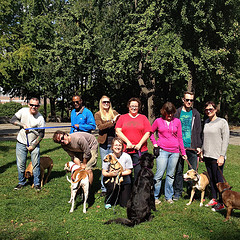Even if you do not have a purebred dog and are not into any type of competition, the American Kennel Club® (AKC) Canine Good Citizen® (CGC) test is a good thing for every dog to pass. The test includes basic manners that a dog should possess in order to survive our urban jungle. More than that, the test is vital if you want to do therapy work (every therapy dog organization requires it) and it can also help you get into housing as some landlords also require proof of passing prior to approval.
Amanda Cornell, MS, CPDT-KA, owner of Accomplished Canines, is a certified AKC CGC Evaluator. Here are her tips to help you pass this important test.
What is the part of the test that dogs fail the most?
In my experience, the Loose Leash Walking portion of the test is the most challenging for dogs. The CGC test is typically administered in either a group class setting and/or a public place. In either scenario, there will be lots of distractions that will be competing with you for your dog’s attention. It’s really easy for young or inexperienced dogs to lose focus. Next thing you know, they are pulling at the end of the leash and the evaluator has to give you a “needs more training” grade for that portion of the test.
How can owners avoid failing that section?
Practice, practice, practice! Loose Leash Walking takes time to master, especially in new and exciting locations. Make sure that your dog has a solid understanding of his “job” in familiar places, like the living room or the backyard. Once you’re sure that he does, take him on short training walks in new areas so that he can start practicing his skills in new environments. Be patient, take some yummy treats with you, and be consistent with your training. Remember, you are training your dog’s leash manners every time that you take him out for a walk (whether you meant to be or not!)
Which element is the hardest to train?
I think that one of the most difficult things for my students is keeping their dog’s attention and focus in a new environment. Being some place new or in a group of new people and other dogs can be really exciting or a little nerve-wracking, or maybe a combination of both, for your dog. Dogs that have been able to perform behaviors at home or in a different class setting, suddenly have no idea what “sit” or “come” means because they are so distracted by the environment around them.
What are some ways of making it easier?
Again, start practicing attention and focus games early on in your training and repeat them often. The more opportunities that your dog or puppy has to get rewarded for paying attention to you in new places and around different kinds of people and dogs, the easier it will be for him to work through those distractions later on.

Are CGC classes the best way to ensure success? Why?
CGC classes are a good start to ensure success for a couple of reasons. First, most CGC class instructors are also CGC evaluators. They provide a wealth of knowledge about CGC test and the exercises that they design for their classes are geared towards helping you and your dog master the skills needed to pass the test. Second, the CGC class environment can provide an additional opportunity to work on improving your dog’s focus around distractions with an instructor watching and offering feedback to help you in your training.
However, keep in mind that going to class once a week for an hour isn’t a guarantee for success. For most CGC candidates, there is a lot of homework that needs to be done in between classes in order for them to successfully meet their goals. Also, most CGC classes are for geared towards dogs that would be considered intermediated or advanced in their basic obedience skills. If your dog is still learning the basics, consider repeating a novice obedience class or maybe some private lessons to get him up to speed before trying a CGC class.
What are your “top” tips to passing the test?
Practice!! There’s just no substitute for actually doing the work.
Ask questions! Your instructors are there to help you train your dog. If a particular homework assignment doesn’t make sense, or isn’t working for you or your dog, let them know. Ask for an alternative or ask for help in modifying the exercise to make it easier. Most instructors will be happy to help!
About the Author
Based in Wilsonville, Ore., animal lover Kristina N. Lotz is a Certified Professional Dog Trainer – Knowledge Assessed (CPDT-KA) and works as a full time trainer. She is the founder of A Fairytail House, a unique all-positive all-sport dog training facility that helps rescue dogs in her area and provides free seminars and training classes for the community. In her spare time, she trains and competes in herding, agility, obedience, rally, and conformation with her Shetland Sheepdogs. She smartly married a Veterinary Technician, who helps keep the fur kids happy and healthy, and provides a quick resource for articles.
 Toledo, United States.
Toledo, United States.